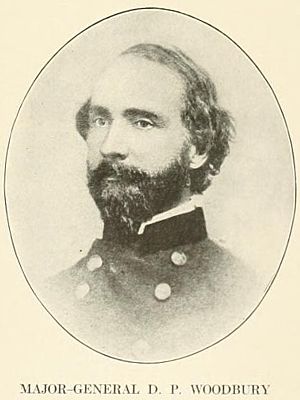Daniel Phineas Woodbury facts for kids
Quick facts for kids
Daniel Phineas Woodbury
|
|
|---|---|
 |
|
| Born | December 16, 1812 New London, New Hampshire |
| Died | August 15, 1864 (aged 51) Key West, Florida |
| Place of burial |
Barrancas National Cemetery, Pensacola, Florida
|
| Allegiance | United States of America Union |
| Service/ |
United States Army Union Army |
| Years of service | 1836-1864 |
| Rank | |
| Battles/wars | American Civil War |
Daniel Phineas Woodbury (born December 16, 1812 – died August 15, 1864) was an important American soldier and a talented engineer. He played a key role during the American Civil War, using his engineering skills to help the Union Army.
Early Life and Engineering Work
Woodbury was born in New London, New Hampshire. He studied at the famous West Point and graduated in 1836. After graduating, he joined the artillery as a second lieutenant.
From 1836 to 1840, he worked as an assistant engineer. He helped build the Cumberland Road, which was a very important early highway. Later, he supervised the building of Forts Kearney and Laramie between 1847 and 1850. These forts were important for protecting travelers in the American West.
In 1851, Woodbury moved back to the East Coast. He also wrote books about engineering. These included Sustaining Walls (published in 1845) and Theory of the Arch (published in 1858). He also oversaw the building of Fort Jefferson and the Dry Tortugas Light in Florida.
Service in the Civil War
When the American Civil War began in 1861, Daniel Woodbury became a major of engineers. He was also a lieutenant colonel on the staff.
He fought in the First Battle of Bull Run. After this battle, he worked on building defenses around Washington, D.C., until 1862. He then led the Engineer Brigade during several major campaigns. These included the Peninsula Campaign and the Northern Virginia Campaign. He was also present during the Battle of Antietam.
Building Bridges at Fredericksburg
At the Battle of Fredericksburg, Woodbury showed great skill. He supervised the building of several pontoon bridges across the Rappahannock River. These bridges were crucial for the Union Army to cross the river and attack. For his excellent work, he was promoted to brigadier general in the regular army.
From December 1862 to March 1863, he continued to serve in the Rappahannock campaign. Later in 1863, he became the commander of the district of Key West and the Tortugas in Florida. Sadly, he died there on August 15, 1864, from yellow fever.

